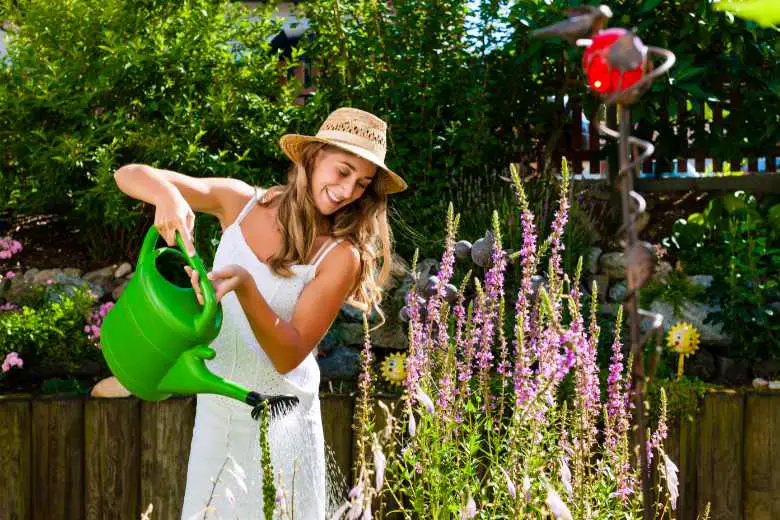
Lavender is a popular drought-resistant flowering plant that is widely grown for its beautiful aromatic blooms and versatility. However, watering lavender plants properly is crucial for their health and ability to thrive. Many gardeners wonder how much water lavender needs as they want to keep their plants hydrated without overwatering.
The answer to how much water lavender plants need depends on different factors like the type of lavender, soil conditions, and climate. In this guide, we will discuss the optimal watering needs and schedule for lavender plants so you can provide the right amount of water to keep your lavender looking its beautiful best.
Analysis of Lavender Plant Water Requirements

When it comes to watering, lavender has specific requirements. Here’s a detailed overview of the water needs of a lavender plant:
1. Soil Preparation:
Lavender thrives in well-draining soil. Before planting, ensure the soil drains well by adding organic matter or sand to it. If planting in pots, make sure the container has ample drainage holes.
2. Watering After Planting:
When you first plant lavender, it’s essential to give it consistent water until it’s established. This typically means watering once or twice a week, depending on your soil and climate conditions.
3. Established Plant Watering:
Once your lavender is established (typically after its first growing season), its water requirements reduce.
- Frequency: Water-established lavender plants once every two to three weeks until buds form, then water once or twice weekly until harvest.
- Amount: Water deeply enough to moisten the soil to a depth of about 8-10 inches.
- Signs of Overwatering: Lavender does not like to remain wet for extended periods. Yellowing leaves or a drooping appearance can be signs of overwatering. Additionally, consistent moisture can lead to root rot, a potentially fatal condition for the plant.
4. Drought Tolerance:
Lavender is a drought-tolerant plant once it’s established. This means it can handle periods without water and is more forgiving if you forget to water it now and then.
5. Winter Watering:
If you live in a region where winters are mild, your lavender may not need much water at all during the colder months. In areas where the ground freezes, water the plants thoroughly in the fall before the first frost to ensure they go into winter well-hydrated.
6. Mulching:
While mulch helps retain soil moisture and reduces weed competition, when it comes to lavender, choose your mulch wisely. Organic mulches can retain too much moisture for lavender’s liking. Instead, consider using a light layer of gravel or sand as a mulch around your plants. This will prevent weed growth, reflect light back onto the plant, and improve drainage.
7. Climate Considerations:
Your local climate will play a significant role in determining how often you need to water lavender. In hot, dry climates, watering may need to be more frequent than in cooler, more temperate areas.
Factors That Affect Lavender Plant Water Needs
- Lavender Type – Different lavender varieties have varying water needs. English lavender is more drought-tolerant than French and Spanish lavender.
- Soil Type – Sandy, clay, or loam soil holds moisture differently. Well-draining soil needs less frequent watering than heavy clay soil.
- Climate/Region – Lavender grown in hot, humid climates requires more regular watering than those in dry, sunny areas with low rainfall.
- Container vs. In-Ground – Potted lavender dries out quicker than those in nutrient-rich garden soil with larger root systems.
- Sun Exposure – Lavender in full sun may need watering more frequently on hot days compared to partially shaded areas.
- Maturity – Newly planted and establishing lavenders need regular water until the roots are well-established, after which mature plants can tolerate drier conditions.
- Rainfall – Natural rainfall can satisfy lavender’s needs on its own, depending on the region’s precipitation patterns.
Signs of Underwatering and Overwatering in Lavender Plants
Its vital to recognize the signs of both underwatering and overwatering in lavender plants to provide them with the best care. Here’s a breakdown in point form:
Signs of Underwatering Lavender Plants:
- Wilting or Drooping Leaves: The leaves and stems may appear droopy or limp.
- Brittle or Dry Leaves: The leaves become dry to the touch and may even crumble when handled.
- Stunted Growth: The plant doesn’t grow as robustly or as quickly as it should.
- Leaf Drop: The plant sheds leaves prematurely.
- Brown Leaf Tips: The tips of the leaves may turn brown and dry.
- Soil Dryness: The top few inches of soil feel dry to the touch.
- Reduced Flower Production: The plant produces fewer flowers or none at all.
Signs of Overwatering Lavender Plants:
- Yellowing Leaves: Leaves turn yellow, especially at the base of the plant.
- Root Rot: The roots turn brown or black and may give off a foul odor, indicating decay.
- Mushy Stems: The base of the plant becomes soft and mushy.
- Excessively Moist Soil: Soil remains wet for extended periods, even if it hasn’t been watered recently.
- Fungus Gnats: These small black flies are attracted to overly moist soil and are often an indicator of overwatering.
- Leaf Drop: Leaves may fall off, similar to underwatering, but they’ll typically feel soft rather than brittle.
- Poor Flowering: The plant may produce fewer flowers, or the buds may become brown and drop before opening.
By paying attention to these signs, you can adjust your watering habits to ensure that your lavender plants remain healthy and vibrant.
Best Practices for Watering Lavender Plants
Proper watering is crucial to the well-being of lavender plants. Here are some best practices for watering lavender:
Best Practices for Watering Lavender Plants:
- Well-draining Soil: Always ensure lavender is planted in well-draining soil to prevent waterlogging and root rot.
- Deep Watering: When watering, do so deeply and thoroughly rather than frequent shallow watering.
- Morning Watering: Water lavender early in the morning. This allows the foliage to dry throughout the day, reducing the risk of fungal diseases.
- Check Soil Moisture: Before watering, check the soil’s moisture by inserting your finger up to two inches deep. If it feels dry, it’s time to water.
- Reduce Frequency with Age: Newly planted lavender requires consistent watering to establish roots. As it matures, reduce the frequency since established plants are more drought-tolerant.
- Avoid Overhead Watering: Use a soaker hose or water at the base of the plant to minimize moisture on the foliage.
- Winter Care: In areas with freezing winters, give lavender a good watering before the first frost to ensure it’s hydrated throughout the cold season.
- Container Planting: Ensure pots have adequate drainage holes, and consider using a cactus or succulent mix to promote good drainage.
- Gravel Mulch: Consider using gravel or sand around the base of the plant as mulch. This improves drainage, reflects light onto the plant, and reduces the risk of root rot.
- Climate Consideration: Adjust your watering routine based on your local climate. In hotter, drier regions, lavender may require more frequent watering than in cooler, temperate zones.
- Monitor Health: Regularly observe your lavender plant for signs of underwatering or overwatering, and adjust your routine accordingly.
Troubleshooting Common Lavender Plant Watering Issues
Certainly! Recognizing and addressing watering issues in lavender plants is essential for their health and vitality. Here’s a list of common problems and how to troubleshoot them:
Troubleshooting Common Lavender Plant Watering Issues:
-
Yellowing Leaves:
- Issue: Often a sign of overwatering.
- Solution: Reduce watering frequency and ensure well-draining soil.
-
Drooping or Wilting:
- Issue: Can indicate underwatering or overwatering.
- Solution: Check soil moisture. If dry, water deeply; if soggy, reduce watering and improve drainage.
-
Root Rot:
- Issue: A result of prolonged waterlogged conditions.
- Solution: Improve soil drainage, reduce watering frequency, and consider transplanting if the condition is severe.
-
Mushy Stems:
- Issue: Overwatering leading to stem rot.
- Solution: Reduce watering and ensure the soil drains well. Remove affected parts of the plant.
-
Brittle or Dry Leaves:
- Issue: Underwatering or excessive sun exposure.
- Solution: Increase watering frequency slightly and ensure the plant isn’t exposed to extreme midday sun.
-
Poor Flowering:
- Issue: This could be due to either underwatering or overwatering.
- Solution: Adjust watering according to the plant’s needs and soil moisture level.
-
Fungus Gnats:
- Issue: Small flies found in overly moist soil.
- Solution: Allow the top layer of soil to dry out between watering. Consider using yellow sticky traps to catch the adult gnats.
-
Brown Leaf Tips:
- Issue: This could be a sign of underwatering or the result of too much fertilizer.
- Solution: Check watering practices and ensure not to over-fertilize.
-
Stunted Growth:
- Issue: This can be caused by both underwatering and overwatering.
- Solution: Assess soil moisture and adjust watering habits accordingly.
-
Soil Stays Wet:
- Issue: Poor soil drainage or overwatering.
- Solution: Ensure the plant is in well-draining soil. Consider repotting or amending the soil with sand or perlite to improve drainage.
Remember, the key to addressing any issue with lavender plants is to monitor their appearance and the soil’s condition regularly. By being observant and making timely interventions, many common problems can be quickly resolved.
Final Thoughts on Watering Lavender Plants
Watering Lavender Plants can be tricky, but with a few tips, you can ensure that your plants stay healthy and vibrant. Watering your plants correctly is essential for their long-term health as it helps them thrive and flower.
Firstly, it’s important to water them deeply and regularly while avoiding overwatering. During the summer months, you should water your lavender once a week and avoid watering during the hottest part of the day.
Secondly, make sure always to use lukewarm water as it helps prevent shock to the plant.
Lastly, it’s important to pay attention to the soil and look for signs of dryness or wilting. If the soil is dry, it’s time to water your lavender plants.
With these tips, you can ensure that your lavender plants will stay healthy and vibrant for years to come.
FAQs About how much water lavender plants need
How often should I water my lavender plant?
Answer: Lavender plants should be watered when the top inch of soil is dry. Depending on the season and climate, this may mean watering every 1-2 weeks.
How much water do lavender plants need?
Answer: Lavender plants need about 1-2 inches of water every week. It is important to water deeply rather than frequently and avoid overwatering.
What happens if my lavender plant gets too much water?
Answer: If your lavender plant gets too much water, it can cause root rot, which can lead to the death of the plant. Be sure to water only when the top inch of soil is dry and avoid overwatering.
Conclusion
Lastly, lavender plants need a moderate amount of water. They should be watered regularly, approximately once a week, with a deep soaking to ensure the soil is completely saturated. It is important to allow the soil to dry out between watering, as too much water can cause root rot. Taking care to monitor the soil moisture levels and adjust watering accordingly is the best way to keep your lavender plants healthy and thriving.







3 Comments